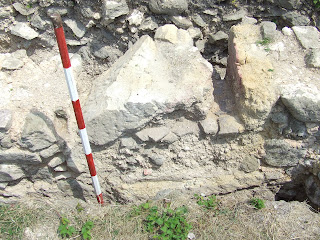At least two of the articles I have published begin with the word reflection.... Archaeologists reflect a lot because while some things are clear, many things are not and we ponder...this actually leads to obsession...
One of the "big" questions at Porolissum concerns the period after the Romans officially left around AD 271. Eighteen sporadic coins dating AD 325-375 have been found at the site over the years although none by the PFP. The latest coins we have found pertain to Severus Alexander (AD 222-235). Other artifacts found over the years have also been designated as "post-Roman". One of the theories is that following the Roman withdrawal from Dacia, the territory was inhabited by the Daco-Romans, namely native Dacians and Romans (perhaps veterans and their families) who presumably remained until the Huns entered Europe in the late 4th century. When we began the excavation, this was among our research questions and because so many archaeologists in Romania discuss the post-Roman phase of Dacia, I have to say that I was biased and began to "see" post-Roman artifacts. The more time I spent digging at Porolissum the more I sought evidence for the post-Roman phase, but the more I looked the less I actually saw.
The PFP has excavated a number of "late" features. In 2009 and 2010 we revealed three hearths and associated post holes, the best preserved of which was in Trench 22N. You would not expect rather crude hearths within Roman public buildings unless the original function of the buildings ceased and "squatters" were using the buildings. In addition to the hearths, we also noted that in some cases the spaces between columns in the porticus surrounding the forum's courtyard had been sealed with crude concrete masonry. With the notion of Daco-Romans in mind, we formulated a hypothesis of settlers making use of the solid architecture of the forum for houses, storage areas, workshops, etc. Afterall, the "Roman" component would have maintained technological knowledge such as the use of concrete.
With some doubts in our mind we planned the 2011, in part, to consider this question. We re-excavated Trench 22N and scrutinized all the archaeological materials we had excavated since 2004. Unfortunately there was no material situated below the "late" hearth in 22N. In reviewing the pottery, coins, etc. we realized that none can be attributed to after the 3rd century AD. There were some fragments that reminded me of 4th and 5th century AD wares from the Mediterranean, but the forms were false friends and in fact bear no relation to the Late Roman wares. Therefore, while we still do not have a firm conclusion, we are more convinced that Porolissum was not significantly inhabited after AD 271. We certainly do not have evidence for a post-Roman settlement. Instead we are considering a hypothesis that the site may have been largely abandoned and/or may have regressed prior to AD 271. Considering the rampant civil wars between rival emperors following the assassination of Severus Alexander, we wonder if troops and civilians may not have begun to move from the region. Economically, the Empire was in poor condition and while there was long distance trade in the Mediterranean, many regions were left the fend for themselves. According to this new hypothesis with a depopulation of Porolissum, say by the 240s/250s AD the last settlers may indeed have resorted to re-using public architecture for survival - hearths in the forum, closing off collanades for defense or housing, etc.
This is no to say that no human being set foot at Porolissum in the period 4th-10th centuries. In fact there is a little evidence. Only time and much study will tell.....



Nessun commento:
Posta un commento